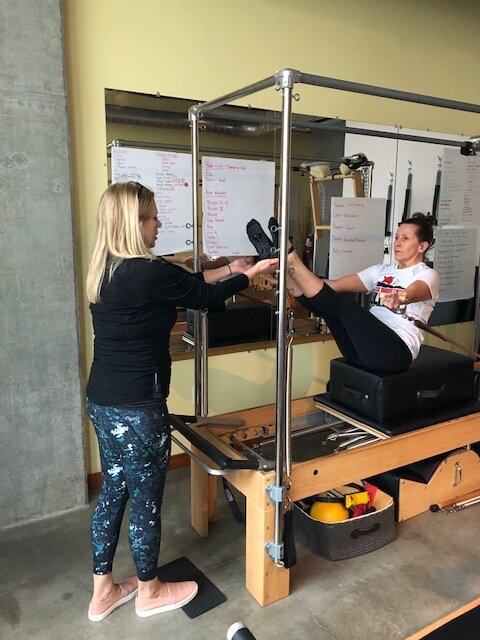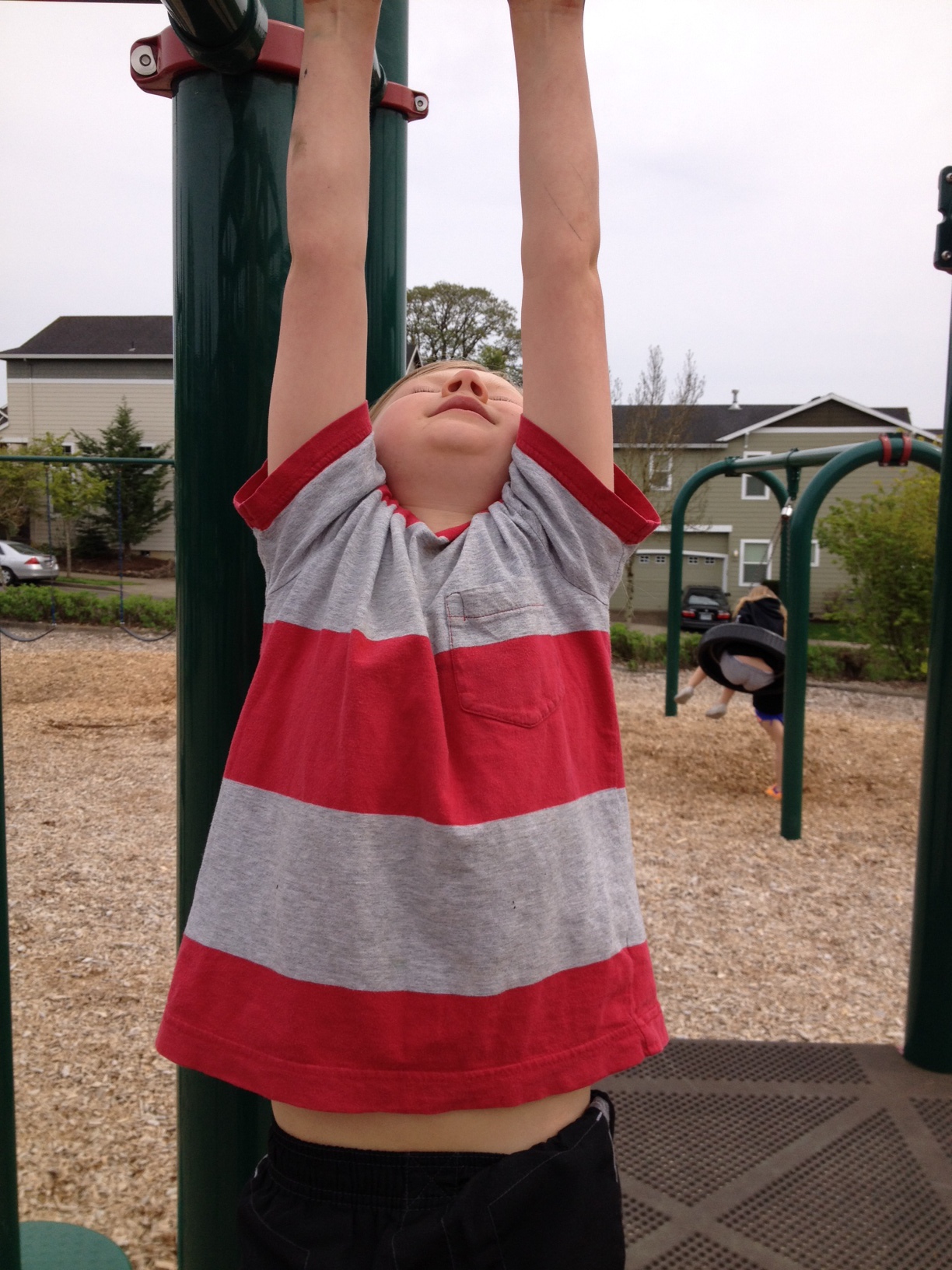By request - here is a short workout video that I do and say the Powerhouse Cues as I move! This video is the best way to start your Pilates practice - enjoy!
Top Three Tips to Conquer your Teaser on the Reformer
Move the carriage out with your arms, move it back in with your butt.
There is a rhythm to the Teaser on the Reformer, and if you cannot find it, it is next to impossible to perform. Press into your arms to get the carriage moving, If you use the muscles of your upper back to get the carriage moving you will have the support to work with the resistance of the swings to lift. This will actually help and make the exercise easier. Next, make sure your eyes are in line with your toes as you lift. If you legs start to spend ahead of your eyes, you will start to tip backwards. So if you cannot come up because you are stuck back, use more upper back strength to move the carriage, and it you’re coming up too fast and fall out of the Teaser when you lift, slow down and make sure your legs are at eye level.
It’s also super important to move your carriage back in with your butt. Using a pelvic curl to close the carriage, try to keep the carriage still until your waistband is on the carriage. People often focus on coming up into Teaser, but if you don’t focus on slowing down the carriage on your return, you won’t build the strength to come up into Teaser.
2. Plan your exit strategy.
Teaser on the Reformer is scary. I kept my knees bent for a long time in this exercise, and at one point, my Master Instructor asked me why (as my legs were straight when I did Teaser on the Mat). I replied that I was scared. “Why?” she asked. “This is lower than your car.” Yikes. So true. But I was scared. A lot of Pilates is scary, maybe we don’t like to be upside down, or balancing on our tailbone on a moving carriage. So plan your exit strategy. What if you start to fall? What do you do? You put your feet down. You stand. So if fear is making you pull back and not try your best, plan what to do if you start to fall, so you can try Teaser on the Reformer with confidence. If we’re scared, we won't really try. Maybe it’s the mind part of the mind/body exercise that you need to conquer.
3. Do Teaser III on the Mat.
In this age of Instagram, it’s easy to see videos of exercises and we want to try them, maybe before we’re ready. Pilates is visual, and fun, and we can sometimes feel like a kid on a playground. But don’t skip the steps that lead up to the fancy stuff. Can you do Teaser III on the Mat? Backstroke on the Box? Jumping into a new exercise before you’re ready can lead not only to frustration, but to injury.
So be safe, be confident, and enjoy the rhythm of the Teaser on Reformer!
How to be Friends with your Client's Physical Therapist
Many of my teacher trainers have mentioned to me that sometimes they feel nervous when their clients start appointments with a physical therapist. They feel like their client might prefer the physical therapy to Pilates and eventually drop their Pilates classes. In my experience, the opposite is true. A talented physical therapist can effectively communicate the unique needs your client has so you can personalize their workouts. With subtle adjustments, based on feedback from the physical therapist, you can help your client get stronger and avoid injury. But how do you do this?
#1 Understand your Role
Unless you have additional training, Pilates instructors are not physical therapists. We work in studios, not clinics. (Even when my husband asks me a question about a nagging injury, I preface my response with “I’m not a doctor.” “I know you’re not a doctor,” he says, “I would know if we’re paying back loans to medical school!”) So yeah, I have a habit of letting my clients know the limit of my knowledge. I’ll say things like “In the past, I’ve worked with (fill in the blank injury or condition)” or “in my experience, that can indicate a (tight muscle or condition), but a doctor would know for sure.” Lying or misleading a client to make them think you have experience you don’t have is never a good idea. Googling a condition does not mean you have experience with a medial condition. I’ve found the more upfront I am with what I know, the more a client with respect and want to work with you. Your reputation is your calling card, and being honest with your certification is of the upmost importance.
#2 Use the Physical Therapist’s Secret Power to your Advantage
Physical therapist have a secret power that Pilates instructors don't have: They have training in diagnosis of injuries. If I have a client with pain in their ankle, I’m not sure it it’s coming from ankle instability or hip tightness (I’ll look at both). But a physical therapist, with the medical training they have, will be able to correctly diagnosis what is causing the pain. I can then use that information to help the client get better.
#3 Know the only question you’ll ever have to ask a Physical Therapist
Physical therapists are busy people. They see people everyday like Pilates instructors, but also have to dedicate time to charting as well. All physical therapists I’ve reached out to have taken the time to help me make sure what we’re doing at the Pilates studio also follows their protocols and recommendations, and I try to make sure they know I value their time by only asking one question: “What muscles do we stretch and what muscles do we strengthen?” It’s so simple, and will only take them a few minutes to jot down a few notes or send quick email. Sometimes I tell my clients to ask that question and have the physical therapist write the answer down. I’ve found this is often how a physical therapist will plan a client’s protocol, and if you know the answer to this question, you can easily work their recommendations into a session (even following the traditional order). For example, for knee injuries, it is commonly recommended to strengthen the lateral muscles of the hip and stretch the IT band and Hamstrings. I now know a basic Reformer Class would be:
Footwork (with the O-ring in parallel or the Power Circle on the outside of the legs to work the lateral muscles)
100 (Keep the ring)
Front and Leg Circles (add IT band and Hamstring stretches)
Stomach Massage (add band or ring)
Short box (cue lateral muscles to hold the strap, add IT and Hamstring stretches after Tree)
Long Stretch Series (no contraindications)
Kneeling Knee Stretches (cue lateral muscles)
Running in Place (band works here, Power Circle not so much)
Pelvic Lift (could narrow foot stance to add band or circle)
****Recommendations only, I am not a doctor :)
****Notice I also used my super power as a Pilates instructor: I worked the entire body, not just the injury.
That specialized lesson for my client took no time at all. I didn’t google exercises I’m not trained to teach. I didn’t pretend to have knowledge I didn’t. I simply took the Physical Therapist recommendations and translated it into my existing base of knowledge. The client will make more progress, work out safer, and make more progress. Meet my new best friend: the physical therapist! We’re part of the same village, making our client stronger!
You Are More than Your Body
I was reading this blog today and this line really struck a chord with me:
"Stress trumps all. Even when the diet and movement are right, you can be undermined by a mind that's bearing a heavy load."
Isn't that true? Every time I've had a major injury, it's been during a very stressful period in my life. I've taken to preemptively doing energy work before a stressful event because my body manifests stress so strongly physically. When I last sprained my ankle, I was a Graduate Teaching Assitant, was completing my Masters, was teaching full time, and completing the highest level of Pilates certification. So was it the movement in the ballet class that injured me? No, it was the heavy load I was carrying in my brain and in my heart.
So, how are you planning on taking care of your mind this year? How can we lessen the load for each other?
This may be my New Years Non Resolution .
The Top 3 Reasons Why Men Should Do Pilates
I know Pilates has gotten a girly reputation, but Joseph Pilates was not a dancer - he was a boxer! How more manly can you get? But I can't tell you how many times people have asked me if I have any male clients. Yes, and do, and here's why.
You get to stretch without taking a yoga class with a bunch of hyper-flexible women. Many of my guy clients know they need to stretch (and did you know that a tight psoas can lead to erectile dysfunction?) but they don't want to be surrounded by super flexible women (women tend to be more flexible than men) with their feet touching their heads while they struggle with straps and blocks to approximate the same position. In every exercise in Pilates, there is a stretch and a strength. So in Spine Stretch Forward, you're working your abs but at the same time you're stretching your hamstrings, but you get to move and flow in the position. You don't have to sit and hold something that may feel intense for 3 minutes.
It helps to open your chest. Many men focus on developing the muscles of their chest, but that can lead to overly tight chest muscles, even kyphosis (and hey, staring at that smart phone all day isn't helping!). Without stretching the chest, over developed chest muscles can cause lower back pain, and tight hips (see reason #1 above for a sneaky way to stretch without forcing yourself into Cobra). Pilates extension for the upper back focuses on opening the thoracic spine without loading the low back - it's more of a sternum lift than an arch of the mid-back. If you're really tight in your chest, deep back bends will only cause more pain. The smaller, more strategic extension in Pilates will help deeper postural changes take effect.
You'll perform better at your favorite sport. Many of my clients (male or female, for that matter) remark on how much more lung capacity they experience after starting a regular Pilates practice. The lateral opening of the side body coupled with the lift of the rib cage in forward flexion is unlike any other exercise system. This means that in your Pilates lesson, you are lengthening your ribs off your pelvis in two directions - to the side (which is easier and will give your body more stretch) and when you round forward (which is much more challenging). But if you can master that, you are training your internal, deepest abdominal muscles to support the carriage of your rib cage. If you can do that, you'll make more space to breathe, helping you increase your endurance for whatever sport you do.
By now, we all know that King James does Pilates.
Are you ready to join him? Or are you already a male student of Pilates? Share your story in the comments!
Go big go long or go home?
I'm often asked by clients how far or long to reach a leg or arm during an exercise, and that's where my often spoken, "Range is determined by form" comes from.
It's most important to keep your critical connections in Pilates - so if by reaching your arm you cannot keep your ribs to your scapula and your scapula to your ribs, you've gone too far. If you don't feel your three anchors, your legs have dipped too low.
But how do you determine where this end range is? It can be different from day to day, and hopefully with improve with time as you commit to your Pilates practice. In general, stay where you are working in your Powerhouse, and let that connection build in a smaller range of motion before taking it bigger. Start at the center, at the Powerhouse, not in your arms or legs. You should feel your arms and legs lengthening out from your Powerhouse connection. Stop when you loose that connection.
My first Pilates teacher made me make the tiniest One Leg Circles I had ever performed, but when I did my hip stopped clicking. I kept working on my Powerhouse connection and one day she said, "I think you can make them bigger now." But it was important for me to keep them small so that the larger motion didn't distract me from my Powerhouse. Momentum is not a muscle group, and it certainly isn't one of the Pilates Principles.
So stay inside the exercise and your body. Really listen to see if you are finding your connection. And don't be afraid to make the movement small and controlled (that one is a Pilates principle)!
New CEC in July!
Peak Pilates® Props Shop (4 Hours)
Set up shop and gain new skills to increase support, resistance and proprioceptive feedback and help your mat students understand and get more out of their workout. Don’t just grab any old prop—develop a thought process that will help you to decide why to choose which prop, how to use them to full advantage, and how to work with flow. Balls, bands, circles, rings and more!
Sunday, July 27th 9am-1pm
What If?
What if what scares you becomes the best thing ever?
So my son came home the other day and told me that the monkey bars are "dumb." In five-year-old kid speak, that translates as "hard." So I've been encouraging him, when we're at the park, to try them different ways -- with me spotting him, supporting his body, pointing out the finder details of other kids' technique...
Ah, the joys of having a parent that studies movement...
And here's what I've learned - the monkey bars are hard. Really hard. And a total core workout. And kinda, um, scary.
I could see fear thoughts when they would drift into my son's brain because it changed how he moved -- more cautious, less sure. So finally, I asked him, "What are you scared of"
"Falling."
"Ok, so do it."
"What?"
"Let go."
So my son let go after he hung for awhile, and he landed on two feet, looked up at me, smiled, and said, "That was fun! I'm going to do that again! I'm going to be an expert faller!"
So what is the scariest thing for you right now? Snake on Reformer? Candlestick on Cadillac? Signing up for an Introductory Series? Registering for a Pilates training?
It may be just the thing that you are best at, the most fun you'll ever have.
Just. Let. Go.



